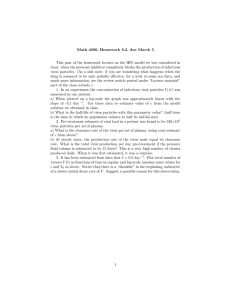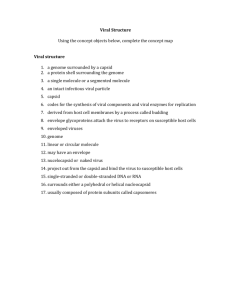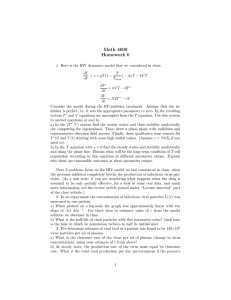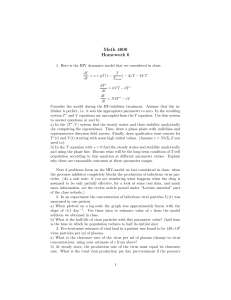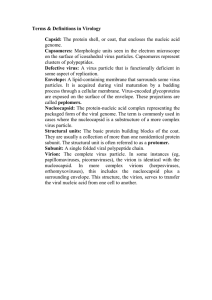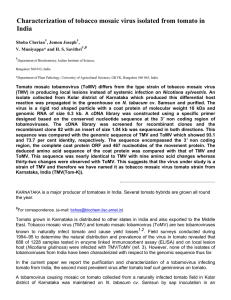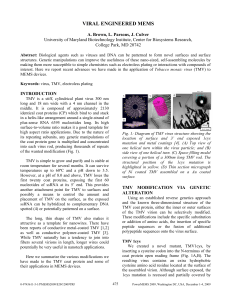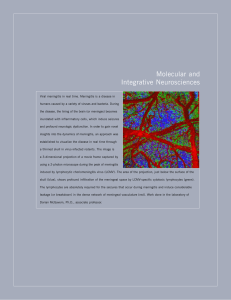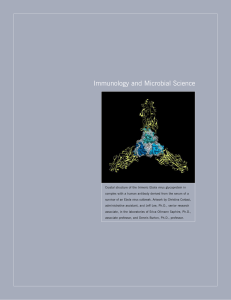RrsnaRcu Ixsrrrurn @ tus Scrupps
advertisement
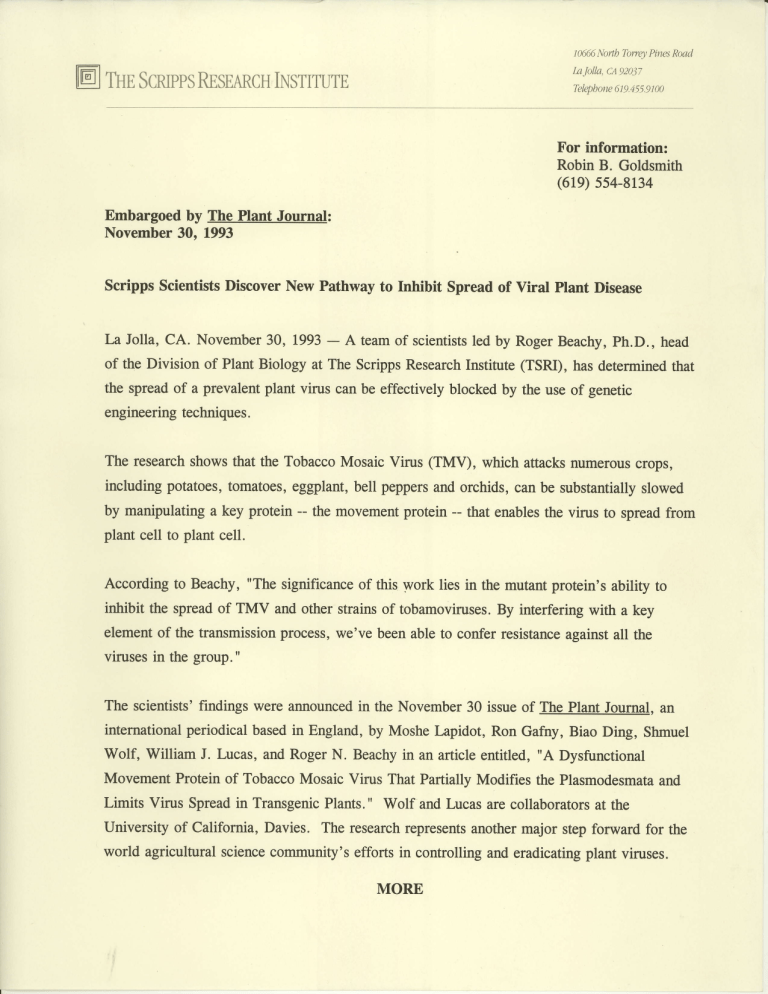
tM66Nottb ToneyPinesRoad ln.FlLa,C:1920.J7 RrsnaRcu Ixsrrrurn @ tusScrupps Telephone 6I 9.45t.9t 00 For information: Robin B. Goldsmith (619)5s4-8134 Embargoed by The Plant Journal: November 30, 1993 Scripps ScientistsDiscoverNew Pathway to Inhibit Spread of Viral Plant Disease La Jolla, CA. November30, 1993- A teamof scientists led by RogerBeachy,Ph.D., head of the Division of Plant Biology at The ScrippsResearchInstitute(TSRI), hasdeterminedthat the spreadof a prevalentplant virus canbe effectivelyblockedby the use of genetic engineeringtechniques. The researchshowsthat the TobaccoMosaicVirus (TMV), which attacksnumerouscrops, includingpotatoes,tomatoes,eggplant,bell peppersand orchids,can be substantiallyslowed by manipulatinga key protein -- the movementprotein -- that enablesthe virus to spreadfrom plant cell to plant cell. Accordingto Beachy,"The significanceof this work lies in the mutantprotein's ability to inhibit the spreadof TMV and other strainsof tobamoviruses. By interferingwith a key elementof the transmissionprocess,we've beenable to confer resistanceagainstall the virusesin the group." The scientists'findings were announcedin the November30 issueof The Plant Journal,an internationalperiodicalbasedin England,by MosheLapidot, Ron Gafny, Biao Ding, Shmuel Wolf, William J. Lucas,and RogerN. Beachyin an article entitled, "A Dysfunctional MovementProteinof TobaccoMosaicVirus That Partially Modifies the Plasmodesmata and Limits Virus Spreadin TransgenicPlants." Wolf and Lucasare collaboratorsat the University of California, Davies. The researchrepresents anothermajor stepforward for the world agriculturalsciencecommunity'sefforts in controllingand eradicatingplant viruses. MORB Page 2 - Scripps ScientistsDiscoverNew pathway to Inhibit Spread of Viral plant Disease The ability of a plant virus to spreadfrom cell to cell is essentialfor establishinga viral infection' However, unlike animalcells, plant cells havea cell wall barrier that virusesmust crossto move from cell to cell. This movementoccursthroughplasmodesmata, channelsthat spanthe cell wall and provide continuitybetweenadjacentcells. These intercellular connectionsplay an importantrole in cell-to-cellcommunicationand provide the route through which water and other substances passfrom cell to cell. However, due to their relatively small sizeas well as the large size of plant viruses,it is assumedthat the structuremust be modified during viral infection. In fact, the movement protein of the tobaccomosaicvirus is known to modi$ the function of plasmodesmata. In this study, Beachy'sresearchteamintroduceda mutantor dysfunctional TMV movement protein *- createdby deletingthreeaminoacids-- into transgenic tobaccoplants. By so doing, they were able to reducethe spreadof TMV from the site of infection to adjacentcells and to upper leavespresumablyby preventingthe gatesof the plasmodesmata from opening as wide as is necessaryto allow virus passage.While the experimentalresultsprove that a mutantmovementprotein can confer a degreeof inhibition of viral spread, the precisenature of the interferenceis unknown. Beachyexplainsthat the mutantattacksa fundamentalprocessin viral movement that is used by many plant viruses. "This is particularlyexcitingbecausethe work confronts a fundamentalaspectof cellular functionthat would makeit virnrally impossible for the virus to overcome"' he says. "It is clear that understanding the cellular mechanisms that underlie reducedviral spreadmay lead to greaterunderstanding of the structure,function and developmentof plasmodesmata.At the sametime it may lead to novel ways to engineer plantsthat resista broad spectrumof virusesthroughthe expression of a singlegene.,, MORE Page 3 - Scripps ScientistsDiscoverNew Pathway to Inhibit Spread of Viral Plant Disease TheseresultscomplementBeachy'spreviouswork that led to the intemrptionof viral replication.This was accomplished by insertinga genethat createsthe outsidecoatingof a virus into the geneticinformationof the cells of a plant. The geneprotectsby producinga small amountof the protein coat insidethe cell. The presenceof the coat protein enhances the cell's resistanceto the virus. Preciselyhow, researchers are not sure,but the coatprotein apparentlyinterfereswith the releaseof nucleicacid from the virus. Beachystatesthat in plantswith coatproteinresistanceas well as a dysfunctionalmovement protein, the resistancewill be additivebecausethey attackdifferent stagesin the infection process. In order to test how broad-based the movementproteinresistancemay be, Beachyhasformed a collaborationwith Dr. Alan Doddsat Universityof California, Riverside. They plan to test the degreeof resistanceby inoculatingthe plantswith a variety of different viruses. In additionto his appointmentat TSRI, Beachyalso is a foundingco-directorwith Dr. Claude Fauquetof the InternationalLaboratoryfor Tropical Agricultural Biotechnology(ILTAB), foundedin 1991as a collaborativeeffort of TSRI and the Institut Frangaisde Recherche Scientifiquepour le Developpement en Cooperation(ORSTOM). Its missionis to improve the agriculturalresourcesof developingnationsthroughthe developmentof disease-resistant crops. Also, ILTAB providespostgraduate training to scientistsfrom developingnationsin the techniquesof cell and tissueculture, virology and moleculargenetics. t+## fftn
